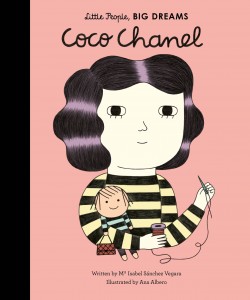Little People, BIG DREAMS Series: Coco Chanel and Frida Kahlo by Isabel Sánchez Vegara, illsutrated by Ana Albero & Gee Fan Eng, RL 2
A few months ago I reviewed two books in the Little People, BIG DREAMS series, non-fiction picture books introducing children as young as five to great women in history. At first, this concept seemed strange to me. Creating biographies for children is always a challenge, taking large ideas and making them bite sized, but after reading my first book in the Little People, BIG DREAMS series I immediately understood the value of these books. It's never too early to introduce children to important people and the idea that they all started off as children and the possibilities could be endless.
Gabrielle Chanel is a perfect example of this. When we first see her, she is at the blackboard in a convent school writing, "To be irreplaceable one must always be different." Learning to sew in school, Gabrielle performed as a singer by night and her fans started calling her Coco. When Coco, "finally went to be, she dreamt in shapes and patterns, She wanted to make so many things!" Vegara makes the important point that Coco Chanel popularized a "brand new style, simple and straight," that freed women from the binding corsets. While the social implications of shifts in undergarment styles for women was massive, Vegara simplifies it for young readers. Backmatter shows photographs and provides a two-paragraph biography of the subject along with further reading.
Like her artwork, Frida Kahlo's short life was filled with pain and beauty and both are a challenge when writing a picture book biography about her. Vegara does a fine job, beginning with her difference and specialness, her leg that is, "as skinny as a rake," due to polio and her choice to dress like a man for a family photo.
After her accident at age eighteen, Vegara charts her long recovery and her work as a painter, which she improved as she healed. Of her marriage to Diego Rivera, Vegara writes, "through their ups and downs, Diego encouraged Frida in her painting." Through her pictures, Frida, "spoke about how she was feeling. In some she looked sad but in others, she smiled." When an exhibition of her work was mounted and came to Mexico, Frida was too ill to attend but, Vegara writes, "it was clear that nothing could stop her from painting - not sickness, pain, or heartache." Vegara ends Kahlo's biography fittingly with her painting, "Vida la Vida, Watermelons," and the words, "Live life."
Source: Review Copy

















